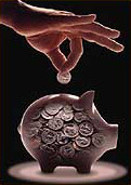Managing Customer Risk
Elisa Mendzela suggests a risk management strategy - with a difference - to grow your market share.



(This article was first published in the Chartered Accountants Journal of New Zealand and is under copyright. If you use or quote from this material please attribute it to the author and publisher.)
Every time you (or any one in your company) communicates with a customer there's a risk. You may provoke a variety of reactions:
- dissatisfy the customer - by not fulfilling needs and/or expectations
- satisfy the customer - by satisfying needs and meeting expectations
- delight the customer - by exceeding their expectations in some way.
Only those who delight can be certain of customer loyalty. We all know it's far easier to keep an existing client or customer than attract a new one. That's not to neglect the quest for new business, but we need to first be mindful of the true value of existing customers - for renewal, repeat business, or (best of all!) referral.
In today's fiercely competitive business environment, customer loyalty is a key success factor. In many industries it's practically impossible to make a difference with the quality and type of product or service offered. For example, most banking services have become commoditized. Banks find themselves in the thick of development projects to seek "better" products to gain advantage over the competition. Most developments are successful but it's never long before competitors catch up or surpass them - for a short while. Then round it goes again.
Once commoditized, businesses can easily get caught in a downward spiral of perpetual discounting - fighting for customer share. Differentiating on product is rarely possible. And differentiating on price alone can spell disaster - unless you're so huge you can command powerful economies of scale.
So how can customer risk be managed? Up to a point, the same way as any other risk - but then comes a crucial difference.
Ask Questions
At least once a year, pause to reflect - on your business position, customer base, and assets (not just balance sheet assets like equipment or stock, but people, expertise, technology etc).
- What are your key markets?
- How are you positioned in each of them?
- What changes are occurring that could affect your business? Are you responding to these events?
- How well aligned are suppliers with your values, wants and needs?
- Are you really serving the needs of your customers - especially the most lucrative? Who are these customers anyway?
- How appropriate is your staff resourcing?
- Do your culture, management systems, and procedures support service excellence, or impede it? How and why?
- How can you build or maintain the enthusiasm, commitment, and competence of your front-line staff (day in, day out)?
Identify the risks
Before even thinking about your staff, you need to know what business you're in and who your customers are. Included here is knowledge of who your most lucrative customers are and what they have in common. What would tempt them elsewhere? Consider how their needs might be changing and what your competitors are doing.
Quantify and analyse. Don't rely on hunches. We're often wrong. Be systematic. Ask questions and find out answers. Core questions should include:
- What brought your customers to you
- What your key customers want
- What they actually get
- How important this is to them
- How you can add further value to them
- How they view you against competitors
Harness technology to help you process information and develop a more personal understanding of, and relationship with, your customers.
Explore Values
Know what it is that your customers are buying from you. What a customer is purchasing may have little to do with the products or services you sell, but something that resonates with that customer's values. Examples might be prestige, dependability, convenience, quality, youthful image, or security. (I recently talked with someone who purchased accounting services from a well-known firm. As we talked it became clear that he was not really purchasing accounting services but rather "prestige", "dependability" and "innovation".) If we can identify what customers are really buying we can tailor products and services to truly match their wants and needs.
More "MAGIC" demands Less Control
In an increasingly competitive business environment, the smoothest, most "customer- friendly" operation wins and retains customers. We can go along quite merrily looking at strategy, collecting and analysing information and formulating risk management plans. However, we may be missing the most vital part of managing customer risk - how to motivate staff to use their creativity and talent to produce superior results. How do we encourage that "X" factor - the personal touch that distinguishes excellent service from the adequate, creates customer delight and raises profits?
It's people, not organisations, who have ideas. People create. People innovate. People build or break businesses. So managing the risk on the people side of the equation is critical. But this doesn't mean control - a command and control approach just doesn't work these days. Let me illustrate why.
"X" minus
During a recent stay overseas I worked with two major retail chains. At the time, the retail sector was stagnant: declining profits, frenzied competition, spiraling discounting. Both chains targeted middle to upper income customers. In many locations, it was possible to walk from one chain's store to the other's, and only cover a block or two between.
One chain operated a "command and control style" of management. This went as far as banning all employee bags in the workplace. Instead management provided employees with a small transparent plastic handbag to place lunch money, handkerchief, comb, or other small item. Each employee had a locker in a room near the staff entry-exit area. This was supervised at all times by security guards.
At the start and end of each day staff went to the locker room and transferred items to/from their transparent plastic bags. Any larger bags were left at security. Contents were always scrutinized, recorded, and ticketed. You were given a receipt on the way in, and handed it in on the way out - if you wanted your bag back! The entire store operated in a similar fashion - Theory "X" operated (employees are not to be trusted. They are lazy (bad) and will only work if you make sure they do…etc)
Staff felt de-motivated. Service delivery (and profits) were taking a tumble. Management's answer - "incentives". Staff received no salary only commissions. Naturally, quite a few employees specialized in "hijacking" customers. This was rife around customer fitting rooms (but could even happen on a dual cash desk - if you weren't fast enough!)
It went like this: As customers exited the fitting rooms, and whilst the employee was hanging the unwanted garments on a rack (a company rule), a poacher would slip in and whisk the customer off to the till. She/he would process the transaction before you could say "Jack Robinson" - responding to incentives. The poacher received someone else's commission - someone who may have spent considerable time and effort helping that customer.
Needless to say a spirit of co-operation was absent within the business. The trendy preaching about teamwork was there, but the practice wasn't. Any supervisors on duty would usually turn a blind eye - they poached too. Staff turnover was high throughout the company.
Not surprisingly, the chain soon filed for "Chapter 11" (bankruptcy).
"X" plus
The other chain I worked with operated a Theory "Y" style (people are basically good and want to work). They managed the risk of customer drift by developing excitement and innovation, founded on a sound and well-communicated strategy. Management created an entrepreneurial culture, with strong staff "buy in" to the vision, values and spirit of the chain.
So during the "tough times" when the Theory "X" chain went under, the Theory "Y" chain (Nordstrom) achieved growth in earnings, and 3 times more profit per square foot of space than their competitors.
Their success was based on ideas like these:
Communicate the vision
At Nordstrom's, staff are left in no doubt about the vision, values and priorities of the organisation. After careful recruiting (with "attitude" more important than experience or product knowledge), staff are welcomed to the company and told: "Our number one goal is to provide outstanding customer service. Set both your personal and professional goals high…"
"Our number 1 rule is to use your good judgement in all situations. There will be no additional rules. Please feel free to ask your department manager, store manager, or division manager any question any time.
"It's an amazing experience - to be part of an organisation in which people are encouraged to achieve their goals and their department's - in whatever way they feel is most appropriate. And it works!
Empower people
What we're talking about is empowerment - a trendy word but a real concept. To me empowerment is sending staff on a drive to somewhere they want to go - somewhere wonderful. You've made sure they are all driving reliable vehicles (recruitment), from spunky 4-wheel-drives to nifty compact cars. Each knows the destination and the expectations (vision, values, goals). You've provided them with the information and support they need to get there (tools and coaching), so they can plan their personal route.
When they arrive at their destination, each can feel achievement and exhilaration. Their planning and navigation were successful - despite highly variable individual approaches.
And don't worry if over the years the vision changes. The world is changing fast, so it's not surprising if your vision changes too. Just keep on communicating, capturing the imagination and enlisting commitment.
Provide information
To be successful, individuals and teams need to measure and monitor their performance, and set and evaluate goals. At Nordstrom's there was open access to all the data needed for this. Each individual could have a clear personal, team-wide, store-wide and (even) organisation-wide understanding of performance. New sales figures were put on display each week, not only for the particular store you were in, but across the entire chain. There was also frank discussion about why targets may or may not have been met. Positive strategies were shared. Coaching was a key part of every manager's job.
Teaming
Nordstrom's distinguishes itself from its competitors by its clarity of purpose and direction and its commitment to staff empowerment and entrepreneurship. However, staff are great team players too. The incentives and recognition programmes, including one in which staff are encouraged to praise and to document outstanding service delivery they see in their colleagues, help build individual and team commitment. Recognising and celebrating individual and team wins is a core strategy, not a feel-good "clip-on"!
Lead by example
Getting buy-in from staff and creating the culture to sustain excellence in customer service (every day!) is a challenge. Staff need management to walk the talk and treat them with the same dignity they would treat customers. In some of the better banks today, you will see managers on the front line, helping out their staff during busy periods. Try and imagine the "branch manager" of the 1970's doing that!
Encourage openness, demonstrate humility and learn
Encouraging honest "appraisal" of one another and of problems and opportunities, and being open about one's own mistakes, helps cement a positive culture. Culture is "caught" not "taught". It is founded on honesty, humility and leadership. You can learn from your staff, just as much as they can learn from you. Learning to recognise that is a powerful step in the right direction for any organisation.
Demonstrate empathy
Another key to managing customer risk is to think like a customer - and get your staff to do the same. Your systems must also be tuned to such thinking. I recently received an invoice from an insurance company for a significant sum. Nowhere on the document was there a heading to say what the Policy was - just a policy number and an amount due. I have a number of policies, so I felt frustrated. The solitary statement "Amount due" wasn't a warm fuzzy either!
Say "Thanks"
Customers have choices. Without groveling, this should be acknowledged. A simple concluding phrase like: "We value your custom" or "Thank you for your custom", would help renew the positive "glow" of that earlier purchase decision.
Achieve consistency - across the whole experience
The chain of customer service is only as strong as its weakest link. For example, at the payment part of the sales cycle you are still vulnerable to customer "drift". This is a moment of truth. Your customer forms an impression of your company here which colours (positively or negatively) the whole service experience he or she has had. To manage the risk of not achieving customer "delight" (and therefore jeopardizing customer loyalty), you need to ensure this part of your service matches the quality of the rest. Is your customer in a hurry to do something else, standing there frustrated because of your procedures or slow technology? Are you annoying them by "adding 30c for the cheque"?
Show courage and perseverance
Trusting people is an act of faith. Occasionally you'll be let down, especially when moving from a control culture to one of empowerment. But if you've got the strategy "sussed", communicated it well, gained commitment, provided support and empowered your staff, they will perform heroics for you and the bottom line will show results.
Managing business risk through leadership in customer service requires real stamina and courage. In the words of Peter Drucker, "In every success story, you find someone has made a courageous decision". It's scary - but it's worth it!